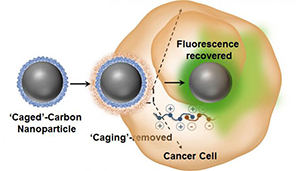
Researchers from the University of Illinois at Urbana-Champaign have developed photo-luminescent carbon nanodots that exhibit reversible switching of their optical properties in cancer cells. The team’s work was published in the Journal of the American Chemical Society.
The carbon nanoparticles could be applied to intracellular imaging and drug delivery, the authors said.
“One of the major advantages of these agents are their strong intrinsic optical sensitivity without the need for any additional dye/fluorophore and with no photo-bleaching issues associated with it,” lead author Dipanjan Pan said in prepared remarks. “Using some elegant nanoscale surface chemistry, we created a molecular ‘masking’ pathway to turn off the fluorescence and then selectively remove the mask leading to regaining the brightness.”
“Using carbon dots for illuminating human cells is not new. In fact, my laboratories, and several other groups around world, have shown that these tiny dots represent a unique class of luminescent materials with excellent biocompatibility, degradability, and relatively facile access to large-scale synthesis in comparison to other popular luminescent materials such as quantum dots,” Pan added.
Pan’s team has previously shown that luminescent carbon dots can be used to simultaneously track and release cargo using hyperspectral imaging and vibrational spectroscopy-based methods.
“We can apply this technique for intracellular trafficking by means of switchable photo-luminescence in mammalian cells in vitro, wherein the endocytic membrane-abundant anionic amphiphilic molecules participates in the ‘de-caging’ process,” Pan said. “The carbon dots, each measuring less than 50 nanometers in diameter, are derived from agave nectar and are highly luminescent. The in situ nanoscale chemical exchange further probed into the mechanistic understanding of the origin of carbon luminescence and indicated that it is primarily a surface phenomenon.
“This can be reversibly turned on and off by a simple counter-ionic nanoscale chemistry,” Pan explained. “These results can become the basis for new and interesting designs for carbon-based materials for intracellular imaging probing cellular function and to study other biological processes.”

